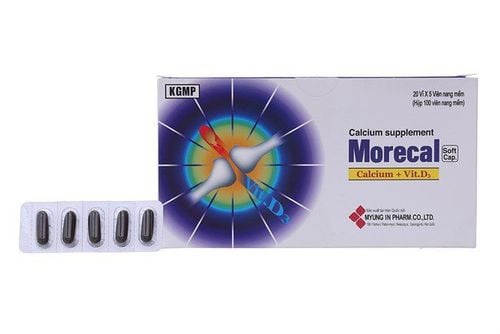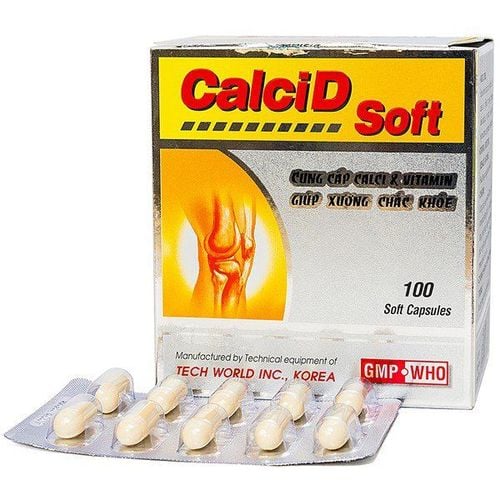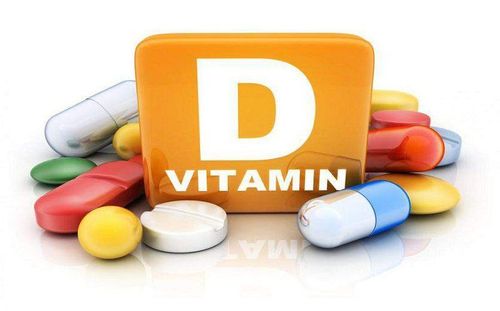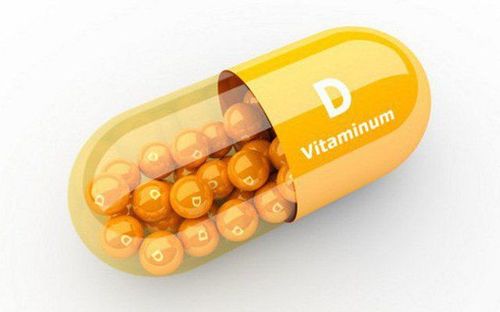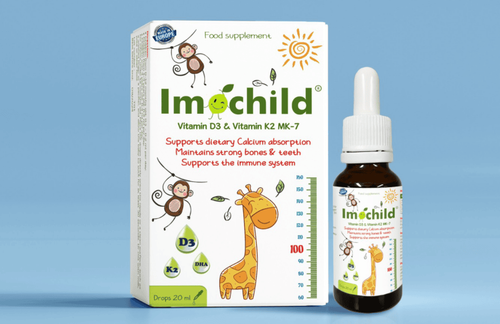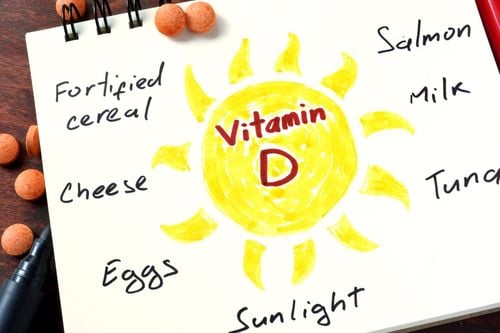This is an automatically translated article.
The article was professionally consulted by Specialist Doctor I Nguyen Thi My Linh - Neonatologist - Pediatrics - Neonatology - Vinmec Danang International General HospitalProper and adequate vitamin D supplementation for children is a measure to help children develop comprehensively both physically and mentally. Children in different age groups will have different needs for vitamin D dosage, so it is necessary to ensure that they provide the necessary amount of vitamin D for children, to avoid deficiency or excess of vitamin D.
1. Vitamin D and its role in the body
1.1 Forms of vitamin D (Calciferol)
Vitamin D includes the following forms:
Vitamin D of vegetable origin: Found in cooking oil, mushrooms,... in the form of Ergocalciferol (D2); Vitamin D of animal origin: Found on animal skin in the form of 7-dehydrocholesterol (D3). Both forms of vitamin D above are precursors under the effect of ultraviolet rays converted into vitamin D. Vitamin D is stored in the liver, higher in liver fish and beef liver.
1.2 The role of vitamin D
Vitamin D plays an important role in creating bone structure by enhancing the absorption of calcium and phosphorus from the gastrointestinal tract, reabsorption of calcium in the renal tubules and participating in bone mineralization. In bones, vitamin D works with parathyroid hormone (PTH) to stimulate calcium and phosphorus metabolism, and increase bone calcium deposition. At the same time, vitamin D regulates blood calcium levels by mobilizing calcium from the bones in cases of calcium deficiency. Therefore, vitamin D is an important substance that helps to regulate the homeostasis of calcium and phosphorus in the body. In addition, vitamin D also plays an important role in cell division, secretion and metabolism of hormones, including insulin and parathyroid hormone. At the same time, vitamin D also affects the differentiation of some cancer cells such as bone cancer, skin cancer and breast cancer. Getting enough vitamin D for your body's needs can help reduce your risk of developing breast cancer, colon cancer, and prostate cancer.
Vitamin D có vai trò vô cùng quan trọng đối với cơ thể
2. Consequences of deficiency - excess of vitamin D
2.1 Vitamin D deficiency
Severe vitamin D deficiency causes rickets in infants and children, and osteoporosis in adults. The subjects at risk of vitamin D deficiency are: premature babies, children with low birth weight (under 2.5 kg), children who are not breastfed, children with infectious diseases (gastrointestinal tract, respiratory tract). ), pregnant and lactating women with little sun exposure, the elderly, people with intestinal malabsorption syndromes, genetic diseases that cause reduced metabolism of vitamin D,...
2.2 Excess vitamin D
If taking high doses of vitamins (dose over 1,000,000 international units for 7 days) can cause vitamin D excess (vitamin D poisoning) with manifestations such as:
Hypercalcemia, which can cause complications hazardous; Children under 1 year old overdose can have convulsions - an excited state due to hypercalcemia, leading to mental retardation, even kidney failure and death; Children in other age groups, if overdosed, can cause poisoning, slow growth because cartilage is early ossification; Taking large doses of vitamin D can cause fatigue, loss of appetite, vomiting, polyuria, diarrhea, and mental confusion. Prolonged hypercalcemia causes calcification of blood vessels and tissues, damage to the heart, blood vessels and kidneys, potentially fatal.
3. The right dose of vitamin D for children
So should vitamin D supplements for babies? The answer is yes. However, to avoid the situation of providing vitamin D lower than the body's needs (causing vitamin D deficiency) or providing a large amount of vitamin compared to the body's needs (causing vitamin D excess), each person should Know the best dose of vitamin D supplements.Specifically, the dosage of vitamin D for pregnant women, lactating women and children is 400IU/day. Prophylactic doses of vitamin D for subjects at risk of vitamin D deficiency are as follows:
Newborns up to 18 months old, if drinking less than 1000ml of vitamin D-fortified milk a day or the vitamin D ration does not meet the 400IU/day should be supplemented with vitamin D 400IU/day continuously; Children 18 - 60 months old only use vitamin D 400IU/day in foggy weather with little sunlight; Babies born prematurely, with low birth weight, twins or with dark skin: From the 2nd week after birth, vitamin D supplements can be prescribed 400-800IU/day continuously for the first 15 months, then switch to the regimen. casual clothes; Children who are not regularly cared for: High doses of vitamin D should be given at intervals. Children 6 - 18 months old should take 1 dose of 200,000 IU every 6 months, children 18 - 60 months old should take a single dose at the beginning of winter of the year; Children and adolescents who are not regularly exposed to the sun but use less than 500ml of vitamin D fortified milk or do not have enough vitamin D 200IU/day should supplement with vitamin D 400IU/day; Pregnant and lactating women, if the diet does not provide enough vitamin D or lack of exposure to sunlight, should take vitamin D supplements at a dose of 400IU - 600IU/day or take a dose of 1,000IU - 1,200IU. /day in the last 3 months of pregnancy or a single dose of 200,000IU in the 7th month if there is no regular sunbathing condition. Commonly used forms of vitamin D for children:
Sterogyl (alcohol-soluble vitamin D2, 1 drop = 400 IU): Take 1 drop of vitamin per day; Infadin (fat-soluble vitamin D2, 1 drop = 800 IU): Take 1 drop per day or every other day as specifically directed by your doctor; Vitamin D3 B.O.N (vitamin D3 oil, 200,000 IU/1ml/tube): Use 1 ampoule every 6 months or can increase to 2 amps every 6 months for children with little light exposure or dark skin as indicated. doctor specific. A daily dose of vitamin D is still the safest measure. At the same time, when supplementing with vitamin D, it is important to limit the use of high doses of vitamin D in prevention and treatment because it is easy to cause excess vitamin D.
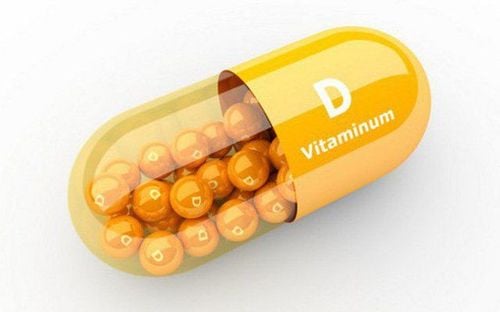
Vitamin D nên được sử dụng đúng liều lượng, độ tuổi để tránh gây thừa hoặc thiếu vitamin D
4. Other vitamin D supplements
In addition to using vitamin D directly, parents can supplement vitamin D for children according to the following instructions:
Build a diet with a variety of foods, using foods rich in vitamin D, calcium, phosphorus,...; Grow kids by mom milk; Pregnant women and infants should sunbathe regularly; Avoid giving solid foods to babies too early, especially premature babies, twins, malnourished children; Prevention and early treatment of diseases related to vitamin D deficiency such as: gastrointestinal infections, respiratory infections, measles, pancreatitis, nephritis,... To have more knowledge about raising children properly, parents Please proactively update useful medical information on Vinmec.com website and immediately contact doctors and experts at Vinmec when you need support.





